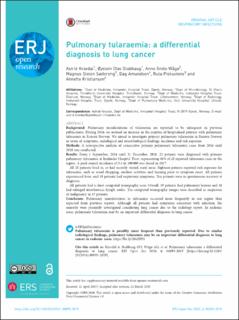| dc.contributor.author | Kravdal, Astrid | |
| dc.contributor.author | Stubhaug, Øystein | |
| dc.contributor.author | Wågø, Anne Grete | |
| dc.contributor.author | Sætereng, Magnus Steien | |
| dc.contributor.author | Amundsen, Dag | |
| dc.contributor.author | Piekuviene, Ruta | |
| dc.contributor.author | Kristiansen, Annette | |
| dc.date.accessioned | 2022-12-06T14:58:25Z | |
| dc.date.available | 2022-12-06T14:58:25Z | |
| dc.date.created | 2021-01-12T14:49:40Z | |
| dc.date.issued | 2020 | |
| dc.identifier.citation | European Respiratory Journal Open Research (ERJ Open Research). 2020, 6 (2), | en_US |
| dc.identifier.issn | 2312-0541 | |
| dc.identifier.uri | https://hdl.handle.net/11250/3036187 | |
| dc.description.abstract | Background: Pulmonary manifestations of tularaemia are reported to be infrequent in previous publications. During 2016, we noticed an increase in the number of hospitalised patients with pulmonary tularaemia in Eastern Norway. We aimed to investigate primary pulmonary tularaemia in Eastern Norway in terms of symptoms, radiological and microbiological findings, incidence and risk exposure.
Methods: A retrospective analysis of consecutive primary pulmonary tularaemia cases from 2016 until 2018 was conducted.
Results: From 1 September, 2016 until 31 December, 2018, 22 patients were diagnosed with primary pulmonary tularaemia at Innlandet Hospital Trust, representing 48% of all reported tularaemia cases in the region. A peak annual incidence of 3.4 in 100 000 was found in 2017.
All 22 patients lived in, or had recently visited, rural areas. Eighteen patients reported risk exposure for tularaemia, such as wood chopping, outdoor activities and farming prior to symptom onset. All patients experienced fever, and 19 patients had respiratory symptoms. Ten patients were in spontaneous recovery at diagnosis.
All patients had a chest computed tomography scan. Overall, 19 patients had pulmonary lesions and 18 had enlarged intrathoracic lymph nodes. The computed tomography images were described as suspicious of malignancy in 17 patients.
Conclusion: Pulmonary manifestations in tularaemia occurred more frequently in our region than expected from previous reports. Although all patients had symptoms consistent with infection, the majority were primarily investigated considering lung cancer due to the radiology report. In endemic areas, pulmonary tularaemia may be an important differential diagnosis to lung cancer. | en_US |
| dc.language.iso | eng | en_US |
| dc.publisher | European Respiratory Society | en_US |
| dc.relation.uri | https://www.ncbi.nlm.nih.gov/pmc/articles/PMC7322898/pdf/00093-2019.pdf | |
| dc.rights | Navngivelse-Ikkekommersiell 4.0 Internasjonal | * |
| dc.rights.uri | http://creativecommons.org/licenses/by-nc/4.0/deed.no | * |
| dc.title | Pulmonary tularaemia: a differential diagnosis to lung cancer | en_US |
| dc.type | Peer reviewed | en_US |
| dc.type | Journal article | en_US |
| dc.description.version | publishedVersion | en_US |
| dc.source.pagenumber | 10 | en_US |
| dc.source.volume | 6 | en_US |
| dc.source.journal | European Respiratory Journal Open Research (ERJ Open Research) | en_US |
| dc.source.issue | 2 | en_US |
| dc.identifier.doi | 10.1183/23120541.00093-2019 | |
| dc.identifier.cristin | 1869940 | |
| cristin.ispublished | true | |
| cristin.fulltext | original | |
| cristin.qualitycode | 1 | |

